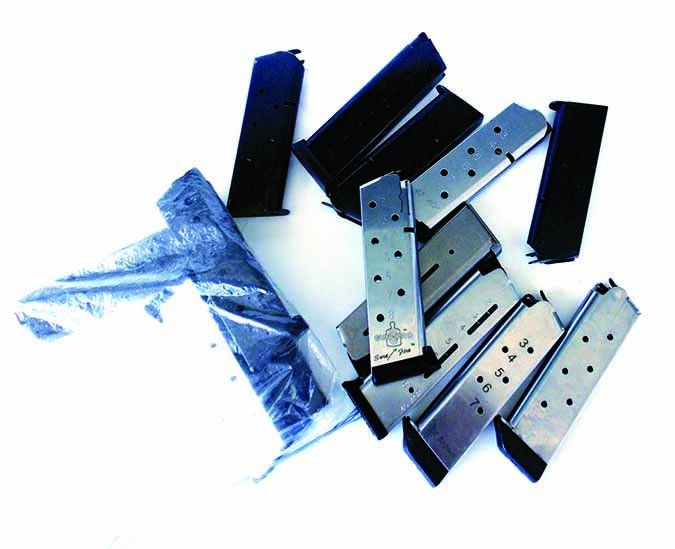
Magazines for the 1911 pistol have evolved more during the past two decades than during any other time since the pistol’s introduction. The bane of the 1911 is cheaply made magazines, with poor ammunition close behind. For many years, the only choices were Colt factory magazines, which were usually high quality, then GI magazines, and poorly made gun-show magazines. Some were marked COLT 45 on the base in bold letters, and these usually meant the shooter was the real deal. At a time when new Colt magazines were around $15, aftermarket magazines sold for as little as $4, and most of them were not worth the aggravation. GI magazines were good quality, but shooters often found them bent and worn out, unless they were new in the wrapper. Quite a bit of barrel feed-ramp polish and tuning of extractors went on that probably was tied to ammunition and magazine problems. Some of the aftermarket magazines were not properly welded. In other cases, the follower was too tight in the magazine body; and in other instances, the magazine springs were weak. Others had poorly attached buttplates, that gave way when dropped on the ground during IPSC competition. Some survived, others did not.
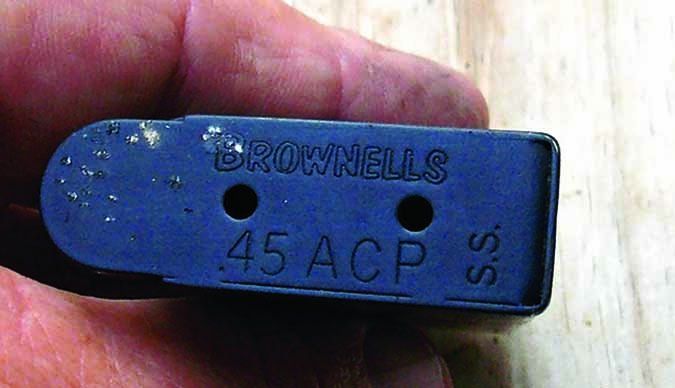
The basic construction of the magazine itself has changed from sheet steel to aluminum and plastic followers versus metal followers. We have examined quite a few magazines that invited a situation called false slide lock. The follower appeared to catch the slide lock, but the slide lock was actually on the wrong shelf, which isn’t good for any of the parts. A 1911 feeds by the loading block on the bottom of the slide stripping the cartridge forward as the slide moves forward. The cartridge case rim catches under the extractor and is pressed forward. Some feel that it is a good thing that the bullet nose snugs a little over the feed ramp and bumps the cartridge case head into the breech face as the cartridge enters the chamber. Some magazines, notably the Wilson Combat, allow the bullet nose to strike much higher on the ramp, which results in missing the feed ramp’s edges more so than others.
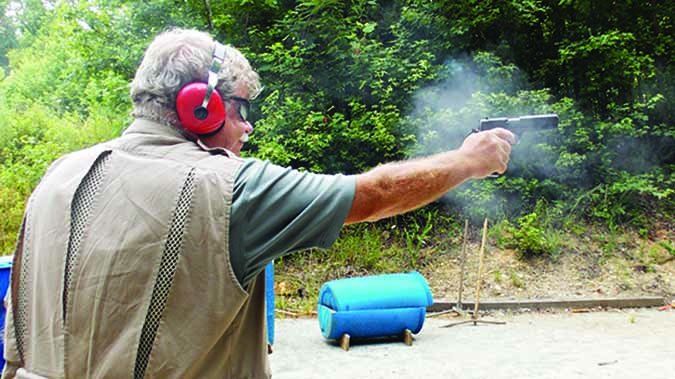
It goes without saying that magazines should be cleaned periodically, dust and lint removed, and that the magazine springs should be checked often to ensure positive function, but we knew design and execution were even further up the pipeline of good function than maintenance, so with this in mind, we elected to test a number of 1911 magazines and to report our findings. In some cases the problems were experienced during testing of 1911 handguns, so we knew what to look for. But, broadly, this has been a long-term test for us. While some tests take weeks to complete, this one lasted 24 months due to the need to keep magazines loaded for a 12-month interval to gauge spring fatigue. Both objective and subjective criteria were used to grade the mags, with function being most important, and fit and finish being behind that.
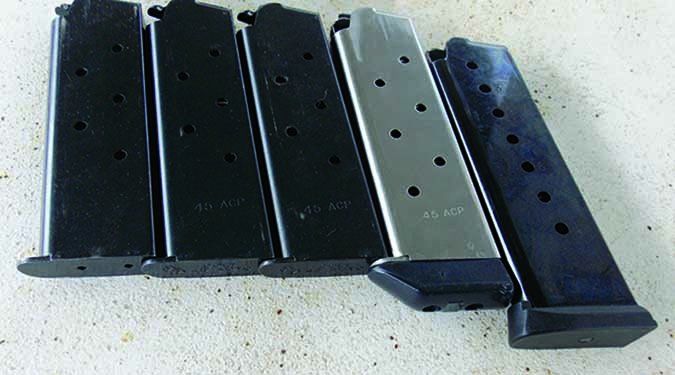
In the test, we used three primary firearms to assess function: a High Standard (Armscor) Government Model 1911, a Springfield Range Officer Operator 1911, and a Remington R1 Commander. All are proven handguns that have proven reliable, with at least 1,000 rounds previously fired in each handgun.
For the magazines themselves, we used at least two examples of each, looking at this lineup of grading points:
Step 1: Making a visual inspection of fit, finish, and welds.
Step 2: Assessing fit of a loaded magazine into the magazine well of each pistol, locking it in place, and closing the slide.
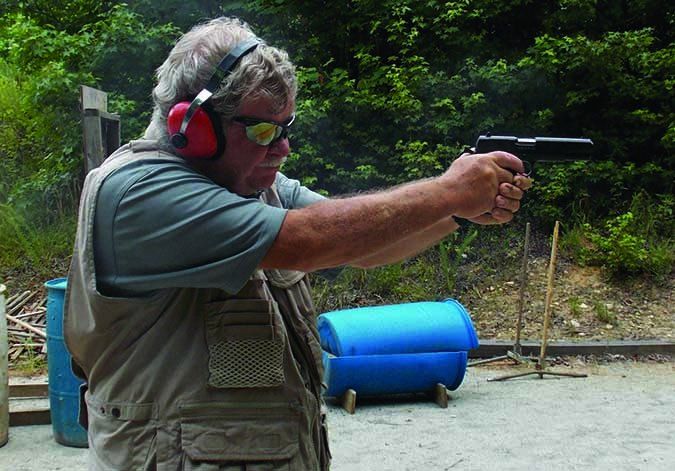
Step 3: Determining difficulty of ejecting an unloaded magazine when the release button is pressed.
Step 4: Noticing any difficulty when dropping the slide on a loaded magazine.
Step 5: Grading feed reliability. Ease of loading and lack of follower binding were noted. We tested the magazines with three loads: A handload using the Magnus Cast Bullets 200-grain semi-wadcutter, properly loaded to a 1.20-inch overall length; a handload using a Hornady 185-grain XTP, also loaded to a 1.20-inch OAL; and a load using the Hornady 230-grain XTP at an OAL of 1.20 inches.
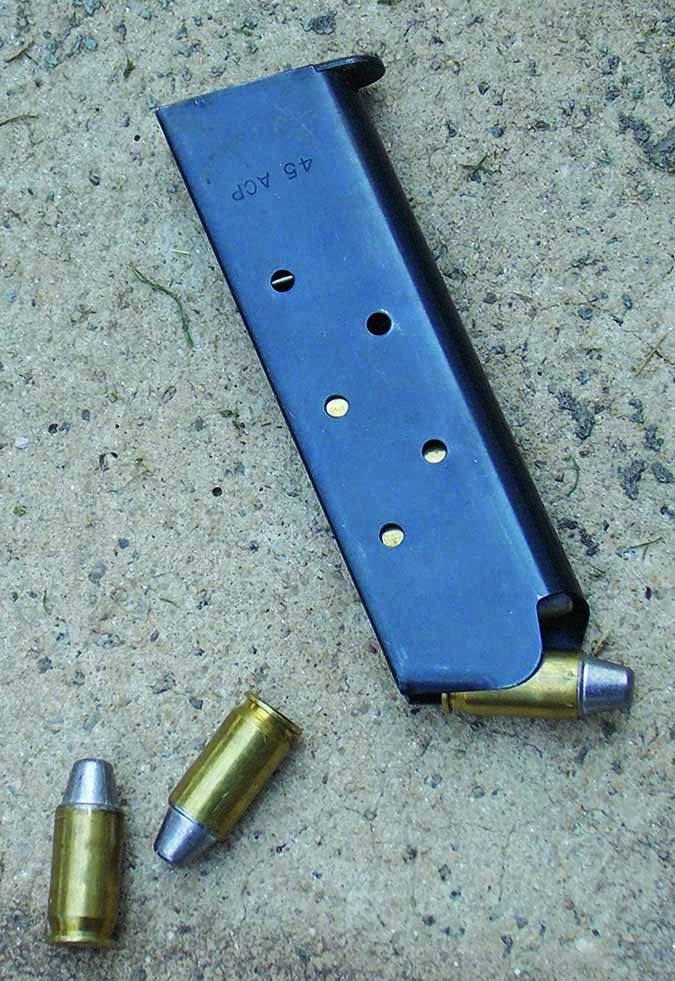
Then we progressed to a firing test. Since +P loads increase slide velocity to the point the magazine spring may not keep up, we fired the magazines that passed previous tests with seven rounds each of a Black Hills Ammunition 230-grain JHP +P. After firing, the follower was checked for excess wear.
Then, for those that remained, we dropped loaded magazines on a concrete pad from 5 feet, attempting a base drop. Each magazine was given two drops. Finally, we left the surviving magazines fully loaded for 12 months topped off with Winchester 230-grain FMJ ammunition. Once the date had passed, they had to come up shooting.
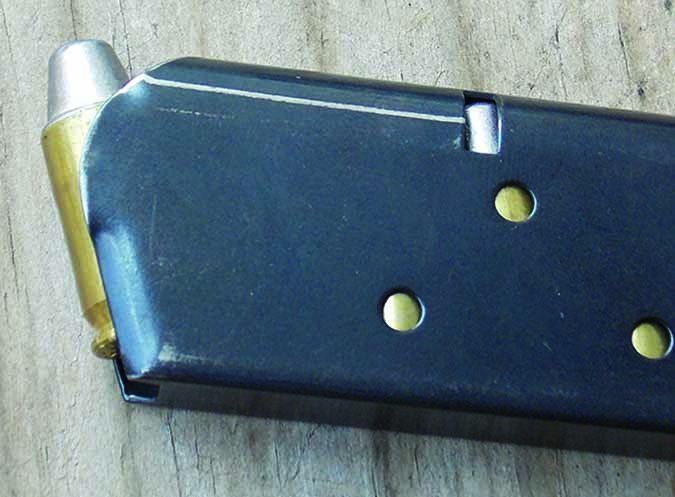
During the test, one of the raters noted that slide-lock function is critical to 1911 handguns. He removed an Armscor 1911 from early testing due to a slide-stop problem. Proper dimensions include a protrusion of 0.200 inch from the back interior of the lever. Slide-stop problems may lead one to believe the magazine is bad. A visual and micrometer test also indicates if magazine feed lips have spread. The original dimensions should be 0.375 inch across the feed lips. All magazines tested were well within specifications. If the magazine feed lips are no longer parallel, then they should be discarded. A measurement of 0.390 inch across the feed lips isn’t good, so at that point, the magazine should be discarded. The only magazine that spread to the point of non-serviceability during the tests was a single Triple K magazine.
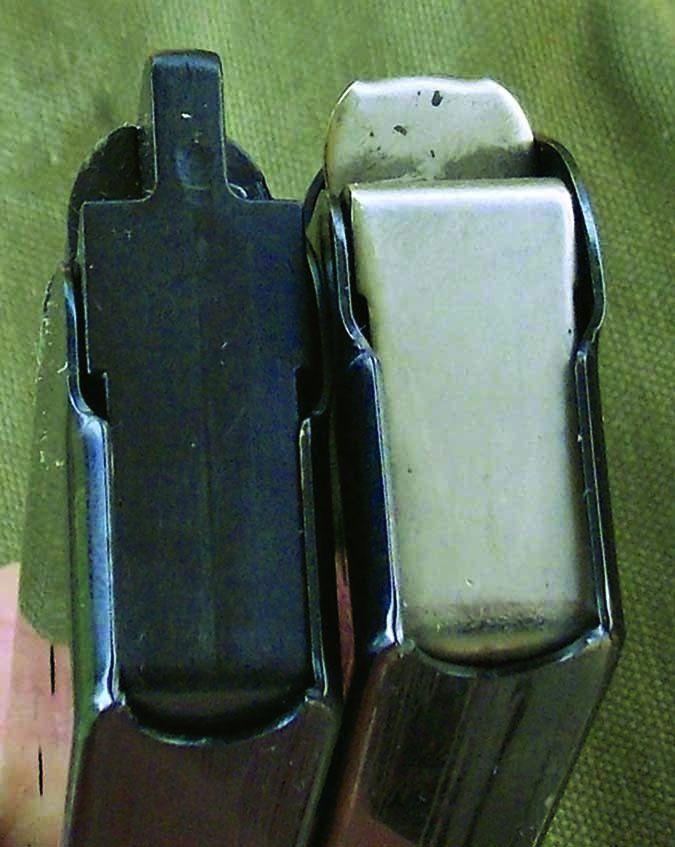
We dropped a magazine or two on the feed lips instead of the base pad, by accident, and despite a reputation 1911 magazines have for thin feed lips, none of the magazines were affected. This was an abuse, rather than a test not included in test criteria. During the drop tests, none of the cartridges popped out the top of the magazine, but rather pushed out forward, as they were designed to feed. Just the same, the tighter the magazine spring, perhaps the less likely the cartridge might be lost. Also a number of raters have seen magazines hit the pavement during competition and seen the base pad come loose and the spring and follower fall out. We dropped the magazines from slightly higher than a normal shooting stance, and the magazines were loaded, but none came apart. Here’s what we found:
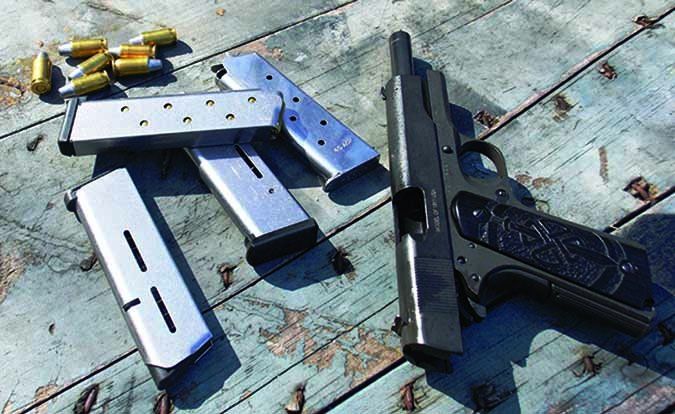
Mec-Gar Magazine, $24
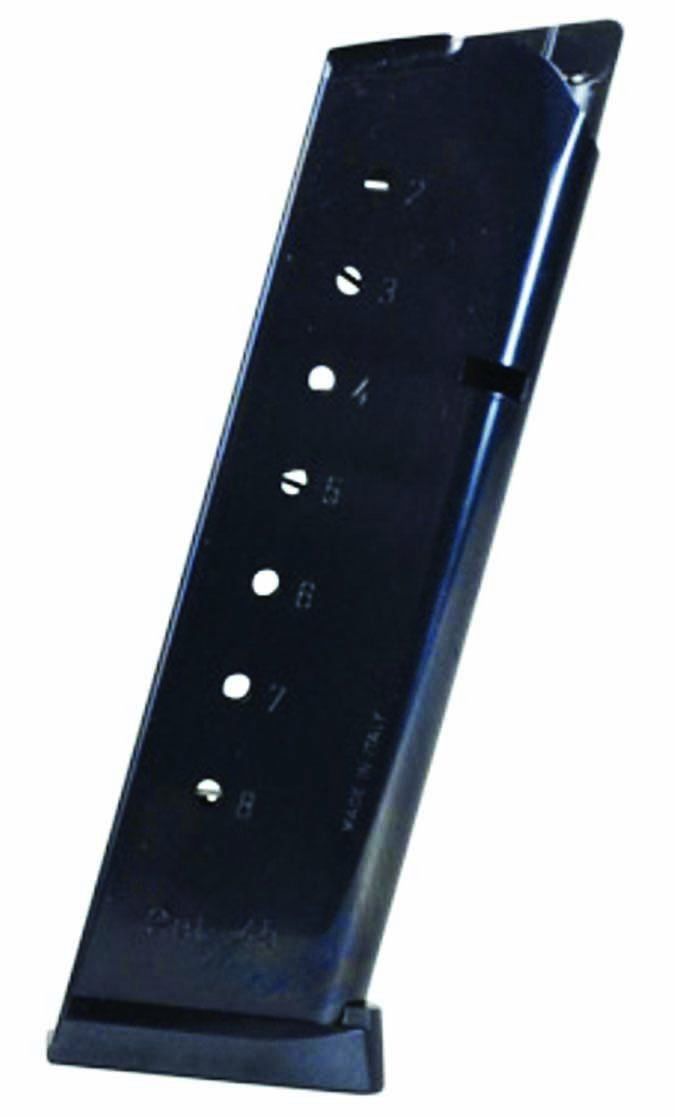
Available from Mec-Gar.com, the Mec-Gar and the ACT Mag are similar in appearance, however, and it is a small thing, the Mec-Gar does not have the ridge or weld line seen on the ACT Mag. We also like the synthetic follower of the Mec-Gar better. The Mec-Gar magazines’ base pads were more secure, however, on a number of magazines tested (and we used a half dozen as they were supplied with Rock Island Armory test guns) two had some loose motion. The Mec-Gar magazines fit as designed, functioned with all loads, passed the drop test without failure, and also passed the 12-month storage test. This magazine was tied with the Brownells for best value, but there are times then the Mec-Gar is found on sale for an even better price.
GUN TESTS GRADE: A (BEST BUY)
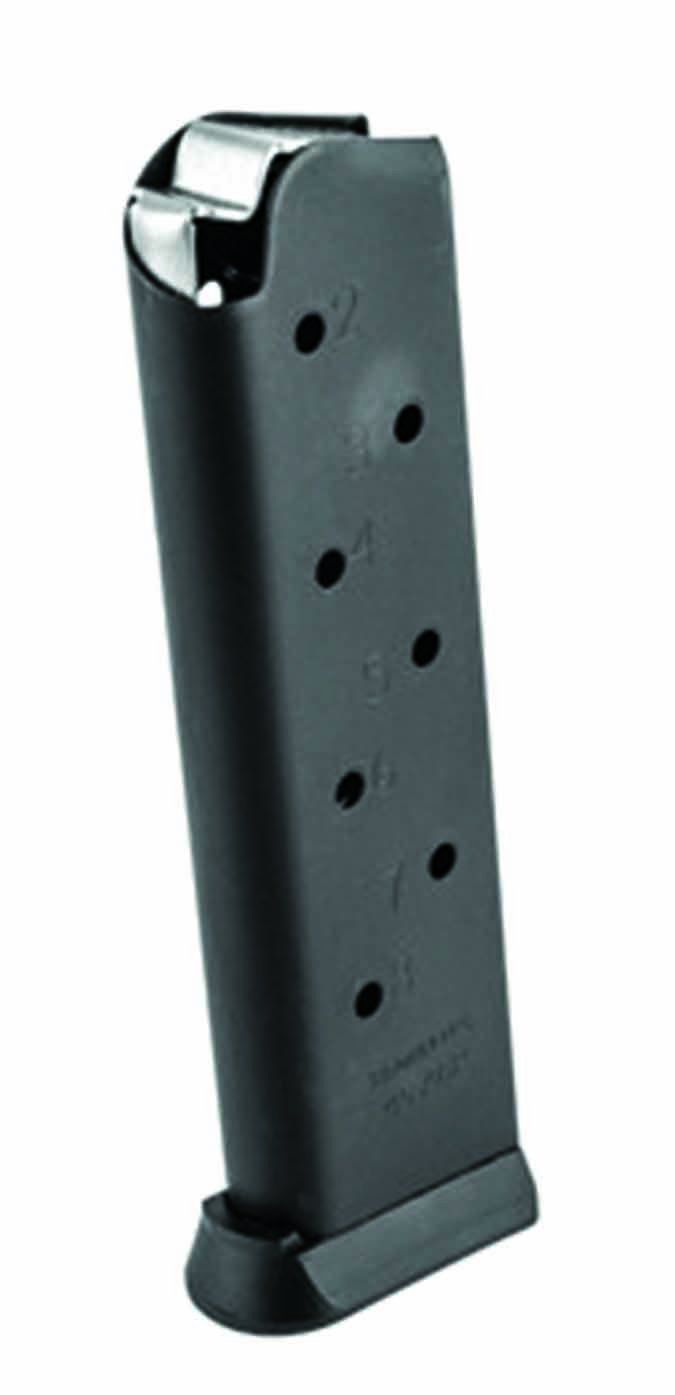
Brownells 1911 8-Round Magazine, $24
Available from Brownells.com, these mags’ fit and finish are good, with a more matte finish than blued. We particularly like the concave follower that rides high in the magazine body. The Brownells magazine is a workmanlike design that aced the tests. These magazines passed all drop tests and firing tests. The price is fair, our team thought, for the performance.
GUN TESTS GRADE: A (BEST BUY)
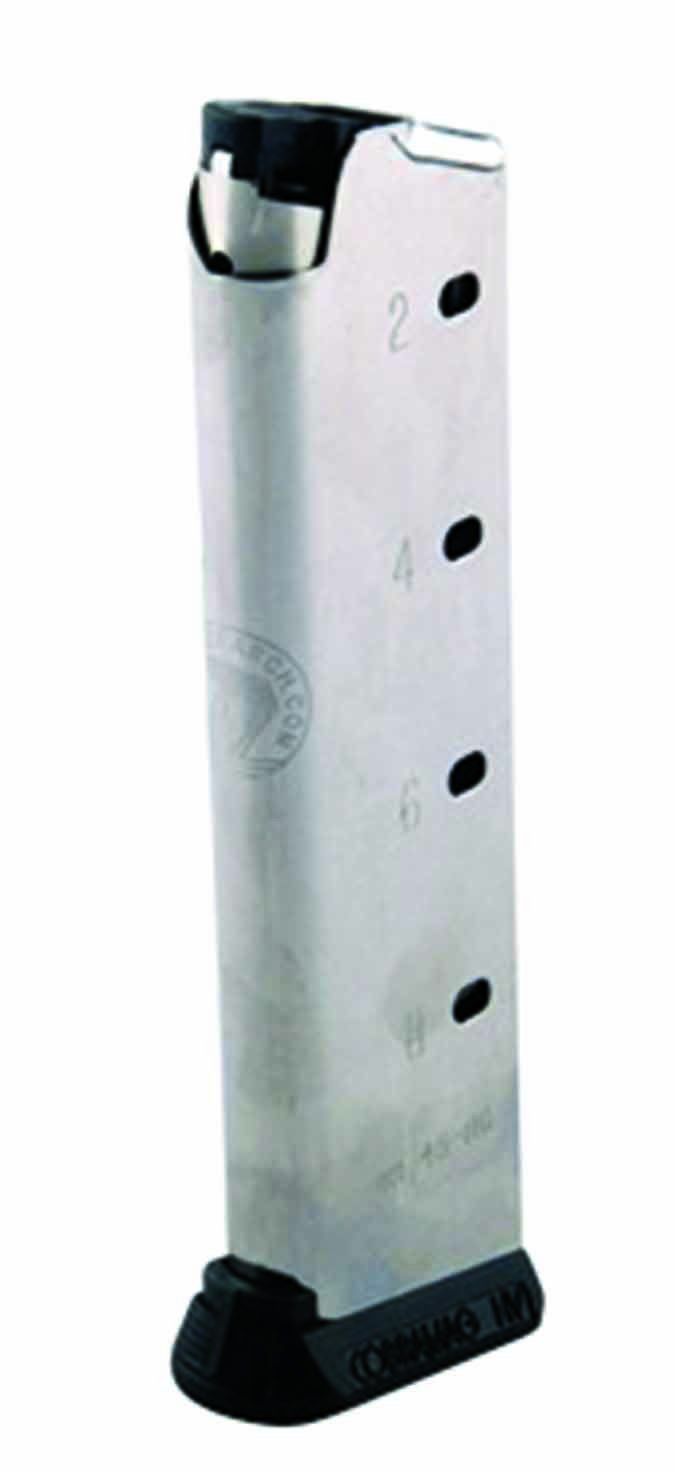
Cobra 8-Round Magazine, $37
Made by Tripp Research and available from Brownells.com, the Cobra magazine showed excellent fit and finish. The magazine presents the bullet nose at a good height in relation to the feed ramp and always gives good feeding. We liked the base pads as well. While pricey, the Tripp-designed magazine aced every test. It is a good magazine worth its price.
GUN TESTS GRADE: A
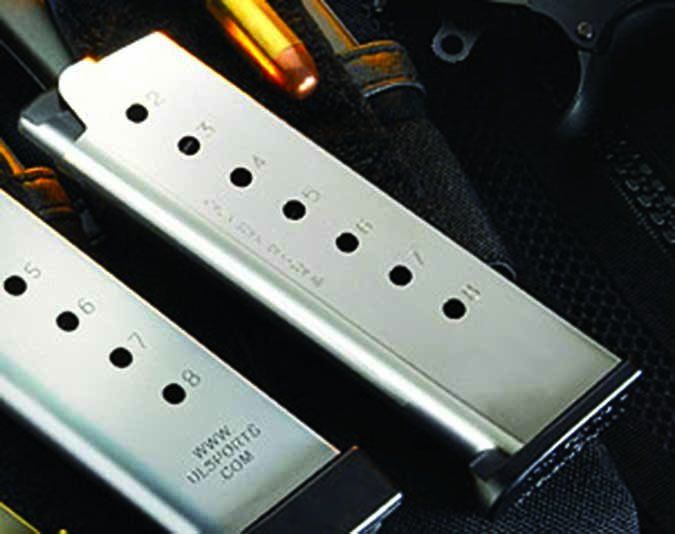
D&L Sports 8-Round Magazine, $50
Available from DLSports.com, this is the most expensive magazine tested. The body is well made and features a rugged finish. The magazine spring is tied with the Ed Brown and Cobra magazine for tightness. The D&L Sports magazines passed all testing, including the 12-month storage test. This magazine is pricey, but it works.
GUN TESTS GRADE: A
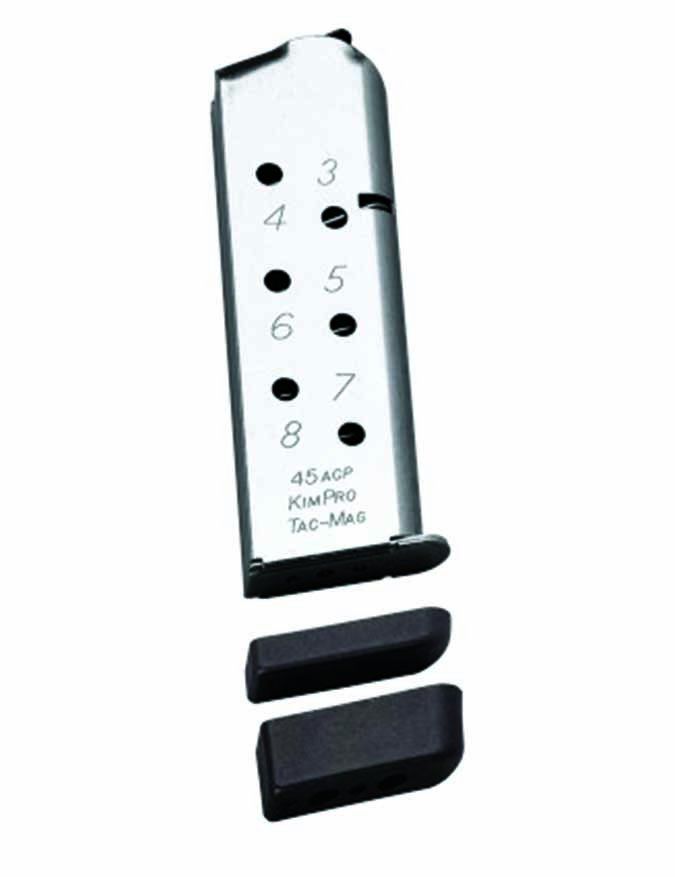
Kimber KimPro Tac-Mag Factory Magazine, $33
Available from KimberAmerica.com, the Kimber magazine is well made and finished and features a flat follower. It is a classic design in appearance and is used in the company’s top-end pistols. Features include Teflon-coated stainless-steel follower, Rocket wire spring, and large round-count recognition holes. A quick-change floorplate permits the immediate attachment of one of three included bases: A conventional stainless-steel plate, slim bumper pad for carry, or a thick bumper pad for competition or use with extended magazine wells. The Kimber magazine is more expensive than the other traditional magazines, and it did not suffer a single failure of any type during the firing tests, drop tests, and long-term storage tests.
GUN TESTS GRADE: A
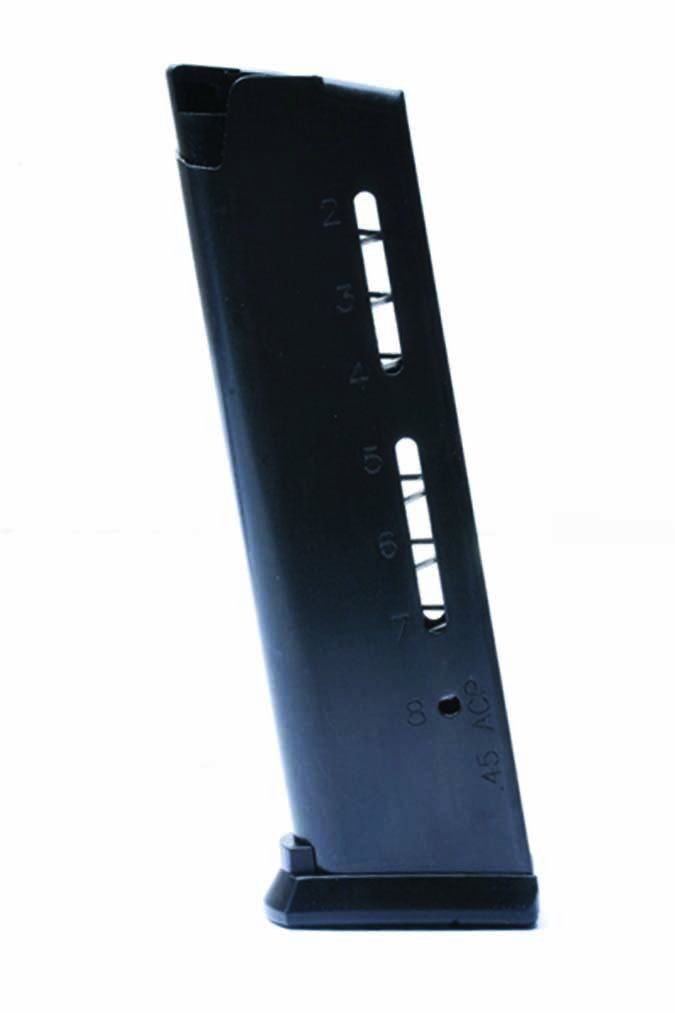
Wilson Combat 1911 Elite Tactical Magazine Full-Size, 8 Round, $33
Available from WilsonCombat.com, the new ETM magazine features a longer body to contain a stronger magazine spring so it will feed eight rounds reliably. Just the same, our most experienced 1911 shooters recommend loading eight rounds total for good reliability; that is, one in the chamber and seven in the magazine. The ETM exhibits good fit and finish. It passed all drop tests, lock tests, feed tests, and the 12-month testing.
GUN TESTS GRADE: A
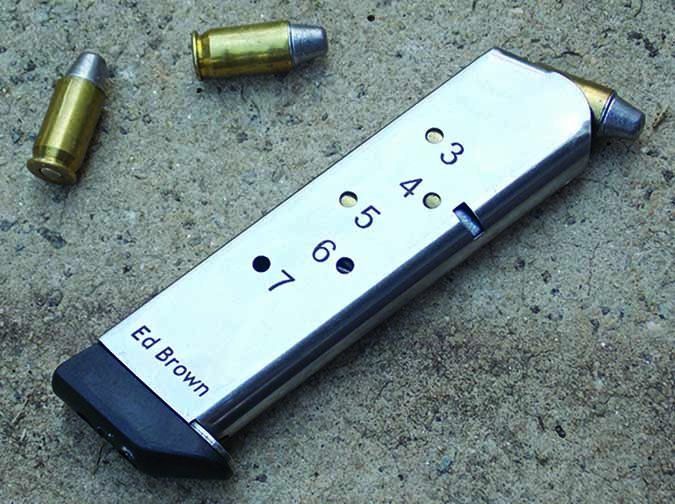
Ed Brown 8-Pack Magazine with Base Pad, $37
Available from MidwayUSA.com, fit, finish, and function of the Ed Browns were excellent. The firing tests were passed without incident, as well as the 12-months-loaded testing. Magazine spring tension, subjectively, was the strongest of the standard-length magazines. Feed reliability is good. The magazines passed all testing save for the drop test, when one of the two magazines lost two cartridges.
GUN TESTS GRADE: A-
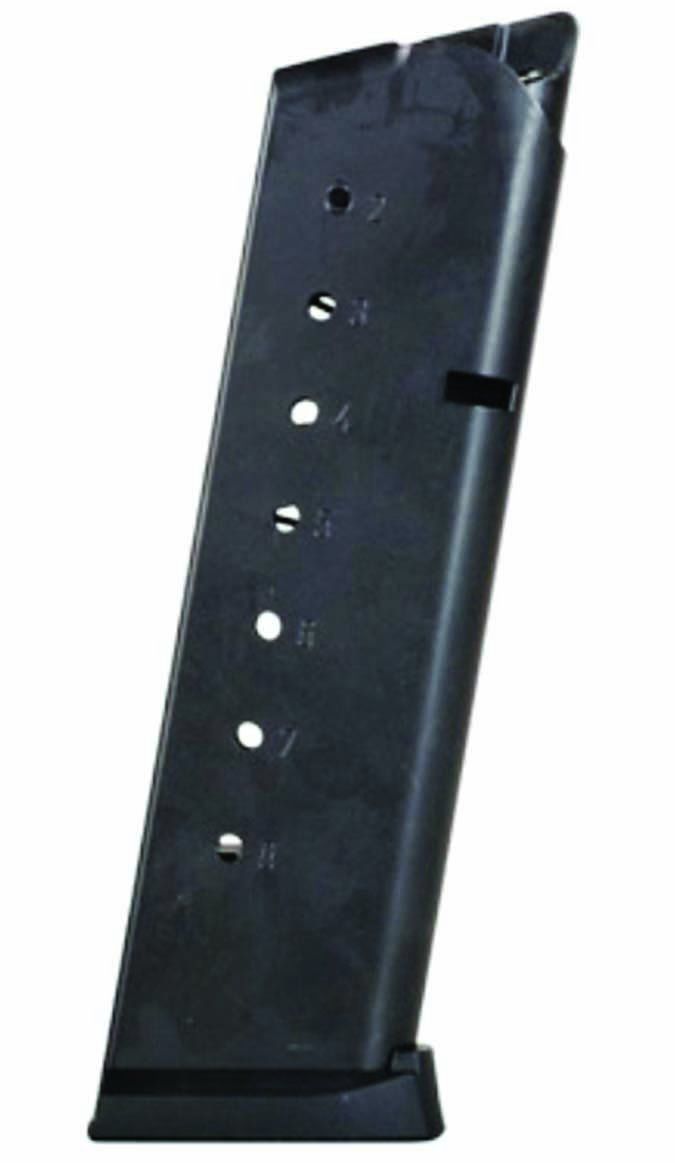
Remington R1 1911 Magazine, $21.70
Purchased from Cheaperthandirt.com, this magazine may be among the best buys in factory-branded magazines. Marked Remington on the base, it works well in all 1911 handguns. Finish is good to match the Remington R1 blued finish. The follower is nylon with a steel insert. During the drop test, the R1 magazines lost two cartridges on average and passed all other tests. We liked these magazines better than the Colt magazines as an example among factory magazines.
GUN TESTS GRADE: A-
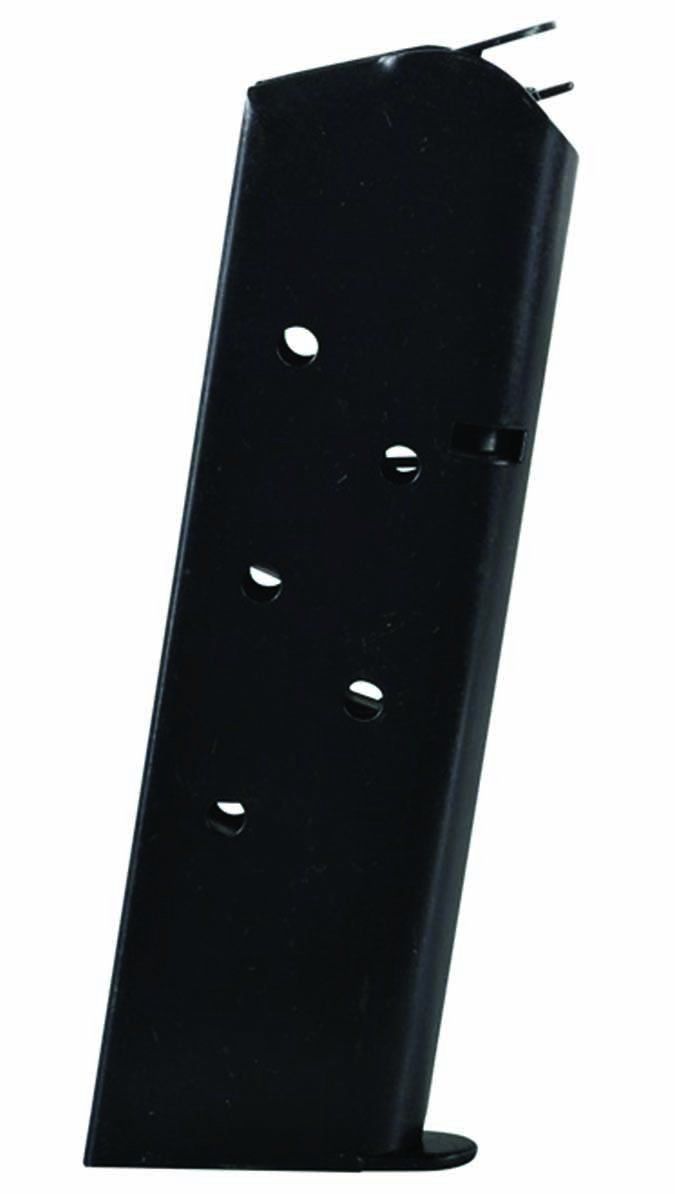
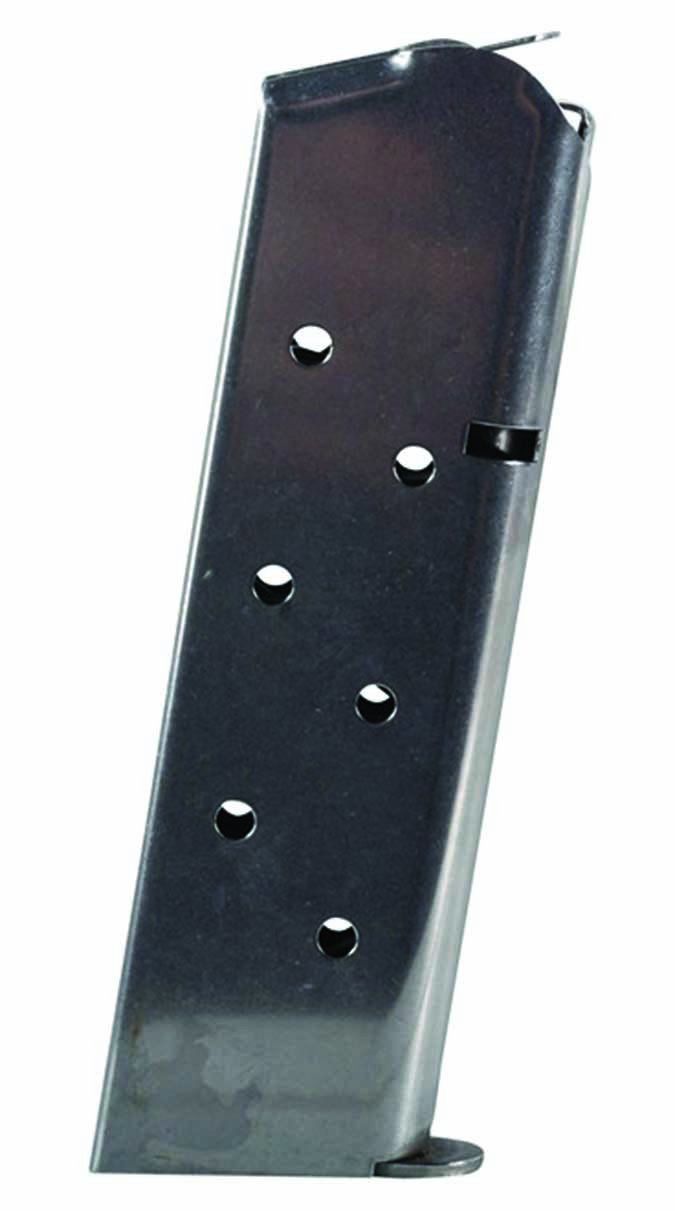
Colt Brand 8-Round Magazine, $22 Blued Steel; $24 Stainless Steel
Available from MidwayUSA.com, the blued magazines were tight going in, but we noticed the stainless magazines were not, for some reason. During drop testing, each Colt magazine lost two to three cartridges. This was true of both blued and stainless magazines. Other firing tests were passed, and all other testing was passed. Coupled with the tight fit of the blued-steel magazines and the drop-test problems, we rated these magazines individually, as noted below.
GUN TESTS GRADE: A- (STAINLESS)
GUN TESTS GRADE: B- (BLUED)
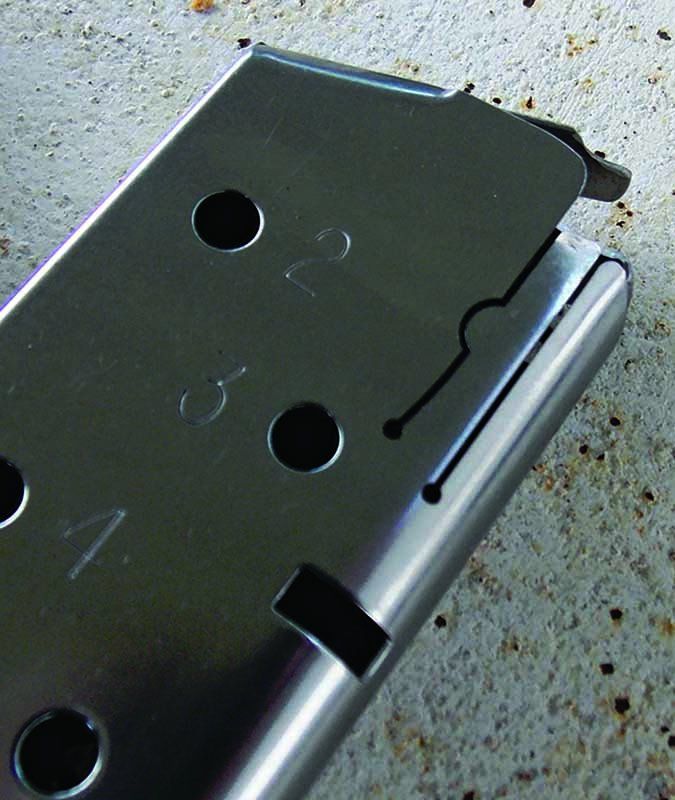
Gun Pro Sure Fire, $35
Available from Gunpro.us, this magazine is advertised as an anti-nose-dive magazine. It is intended to prevent the bullet nose from pushing downward on the feed ramp. The tab that accomplishes this may work best with FMJ bullets. The Gun Pro magazine is similar in appearance to other magazines. There is space in the magazine body for the 8-round follower and magazine, and it isn’t a compressed design. The difference is that at the right side of the magazine body, there is a cut-out section that is reminiscent of a frame-lock knife. The tab doesn’t affect normal feeding, but would possibly prevent a bullet nose dive. At any rate, the magazine is well made and works as designed. During the drop test, the magazine lost an average of one cartridge in each example.
GUN TESTS GRADE: A-
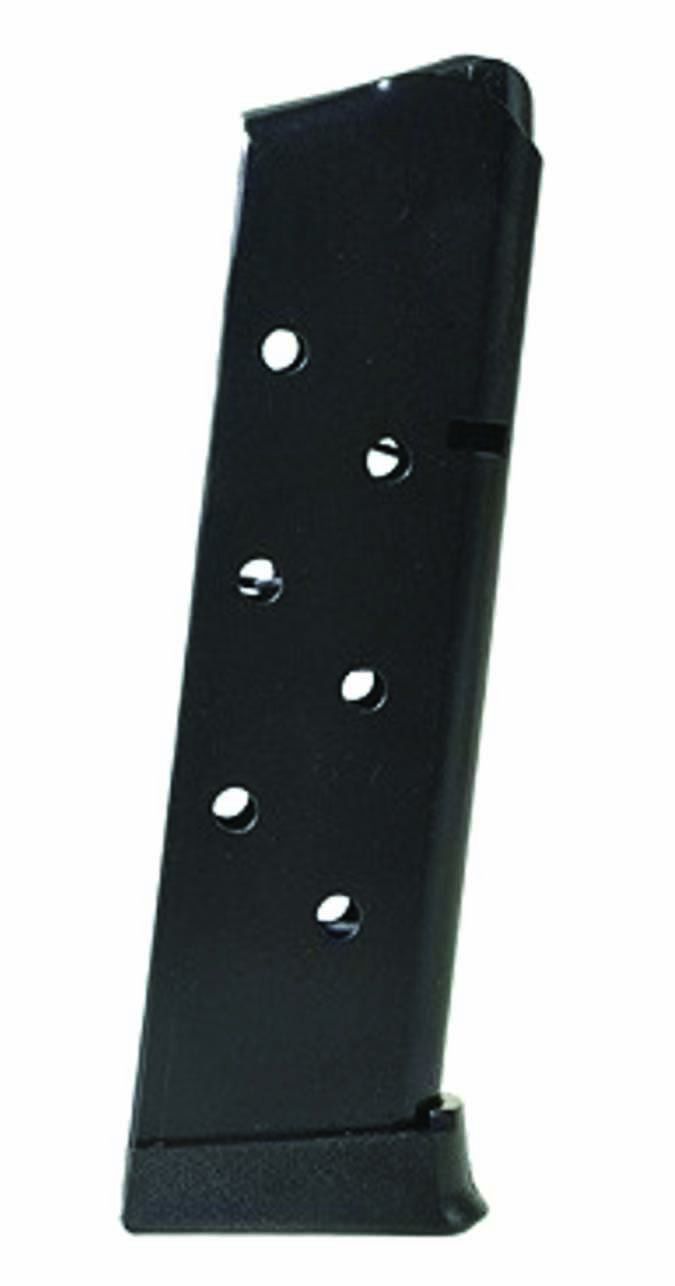
ProMag Magazine 1911 8-Round Steel, $25.49
Available from PromagIndustries.com, these are listed for $25.49 at the ProMag website. But we walked into the local Academy Sports and picked up two at $20 each. Fit and finish were OK, however, we did not like the light-feeling magazine spring pressure. Also, the base pad wasn’t rock solid, but neither was it very loose. The ProMag did not regurgitate any cartridges during the drop test. It also passed the 12-month test. The only blip was a failure to feed during firing of the +P loads. This was because the slide velocity overcame what we perceived as a weak magazine spring. Just the same, overall the magazine did well. Based on rattling when shaken and a failure with +P loads, we rated the ProMag down a full grade.
GUN TESTS GRADE: B
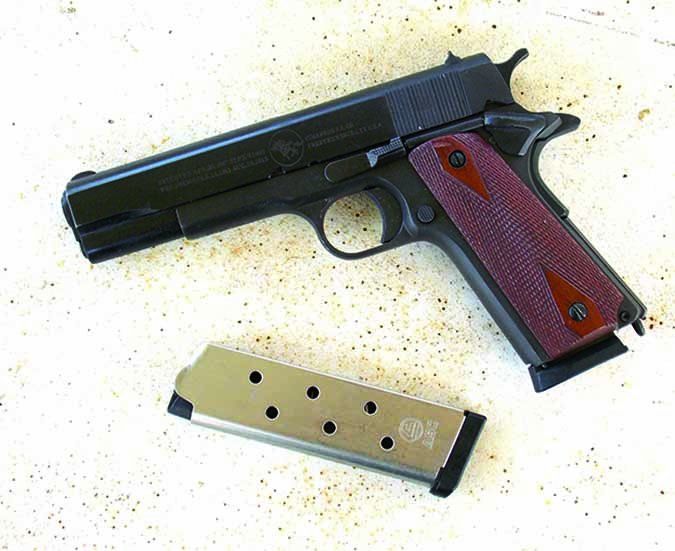
ASC Magazine, $13
Available from Surplusammo.com, this is the least expensive magazine tested. The ASC passed all firing tests. Fit and finish of the ASC is OK. However, the base pads had loose fore and aft motion. During loading, the follower body tended to bind at the rear. While the magazine locked in and functioned, one of the two magazines failed to lock the slide open on the last shot in each pistol from the beginning. The other occasionally failed to lock the slide open on the last shot. Each passed the drop test without losing a cartridge, and both also passed the 12-month spring-fatigue test.
GUN TESTS GRADE: B-

ACT Mag 8-Round Magazine, $22
Available from ACT-mag.com, the ACT Mag is comparable to the Mec-Gar in appearance, but with more noticeable welds. The ACT MAG passed all firing tests. There was more play in the base pad than we like. The magazine passed all testing, save for an average of a single round popping out of each magazine during drop testing. While similar in appearance to the Mec-Gar, we prefer the Mec-Gar based on finish and less play in the base pad. We also like the Mec-Gar follower better. The rating was based on rounds popping out during the drop test and the looser base pads, which were not as loose as the ASC magazine.
GUN TESTS GRADE: B-
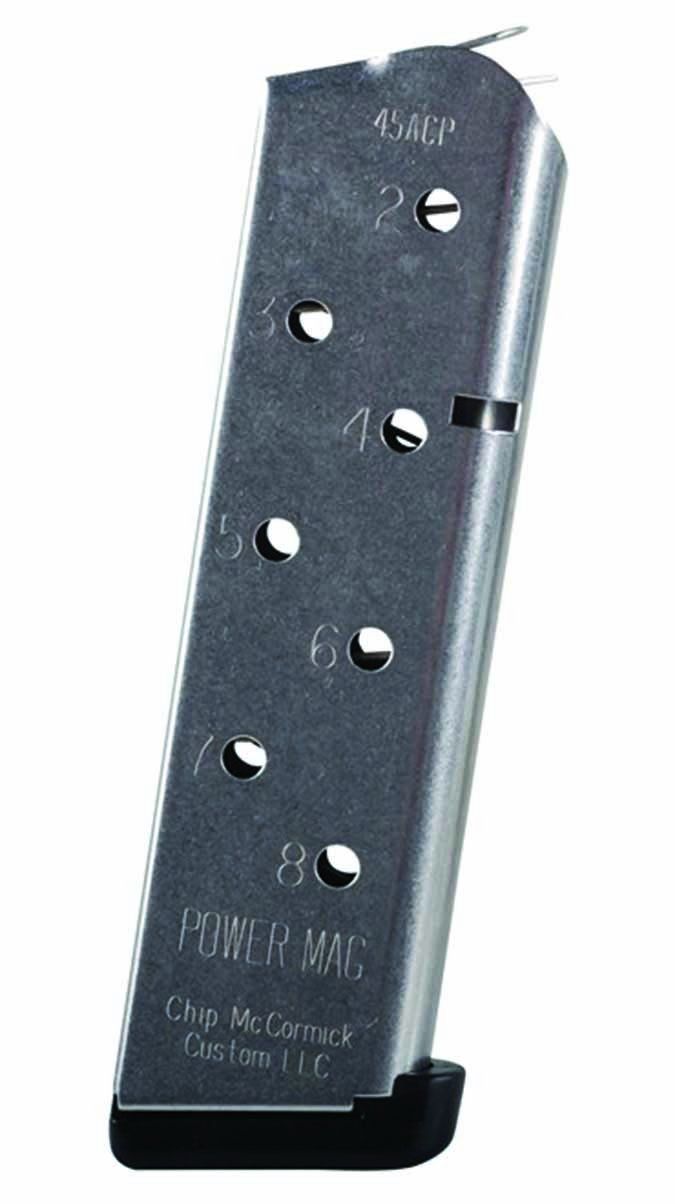
Chip McCormick 8-Round Magazine, $33
Available from ChipMcCormickmags.com, four examples of this popular magazine made it into the test. Fit and finish were good. However, one magazine was tight going in the magazine well. During firing of the +P load, one of the magazines proved to have a weak spring and short cycled. Other tests, including the 12-month test, were passed. We rated the magazines down based on one failure to feed and the tight fit of a magazine.
GUN TESTS GRADE: B-
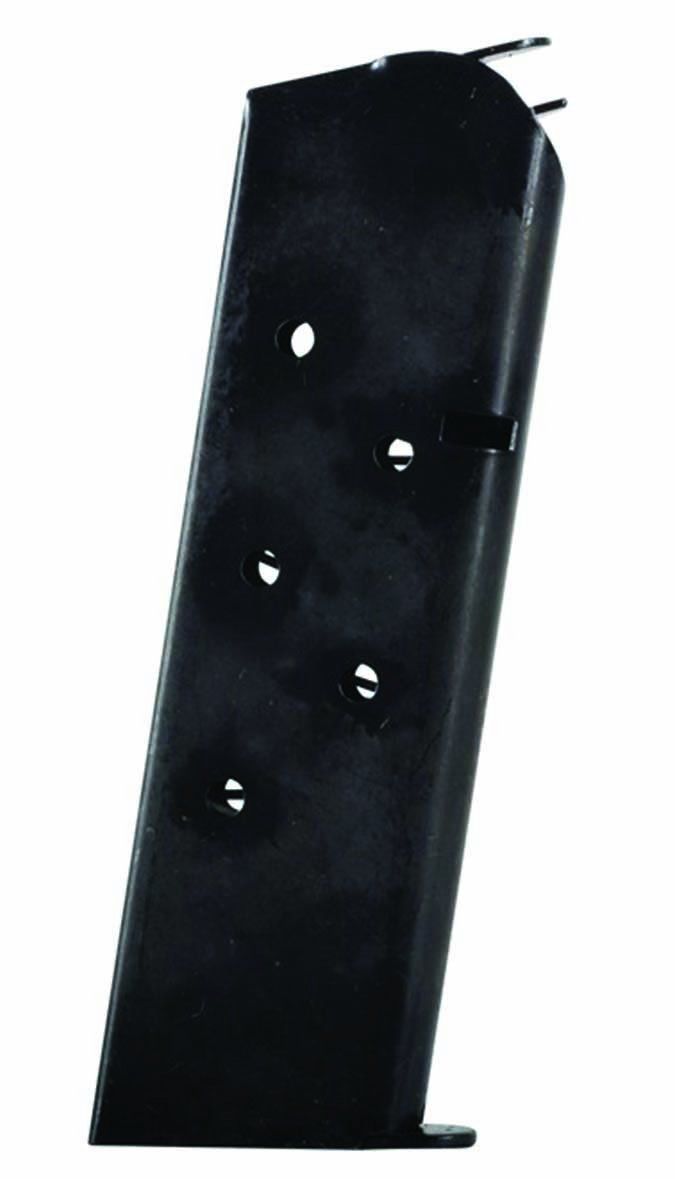
Springfield Armory Factory Magazine, $23.50
Available from Springfield-Armory.com, one of the magazines delivered new with a TRP pistol caused a short cycle. We looked closer and found it was not a 1911 break-in malfunction, but instead a problem with a weak magazine spring. During the drop test, the Springfield magazines lost two cartridges on average. We rated the magazine down a full point on this weak spring and a half point on losing the cartridges during the drop test.
GUN TESTS GRADE: B-
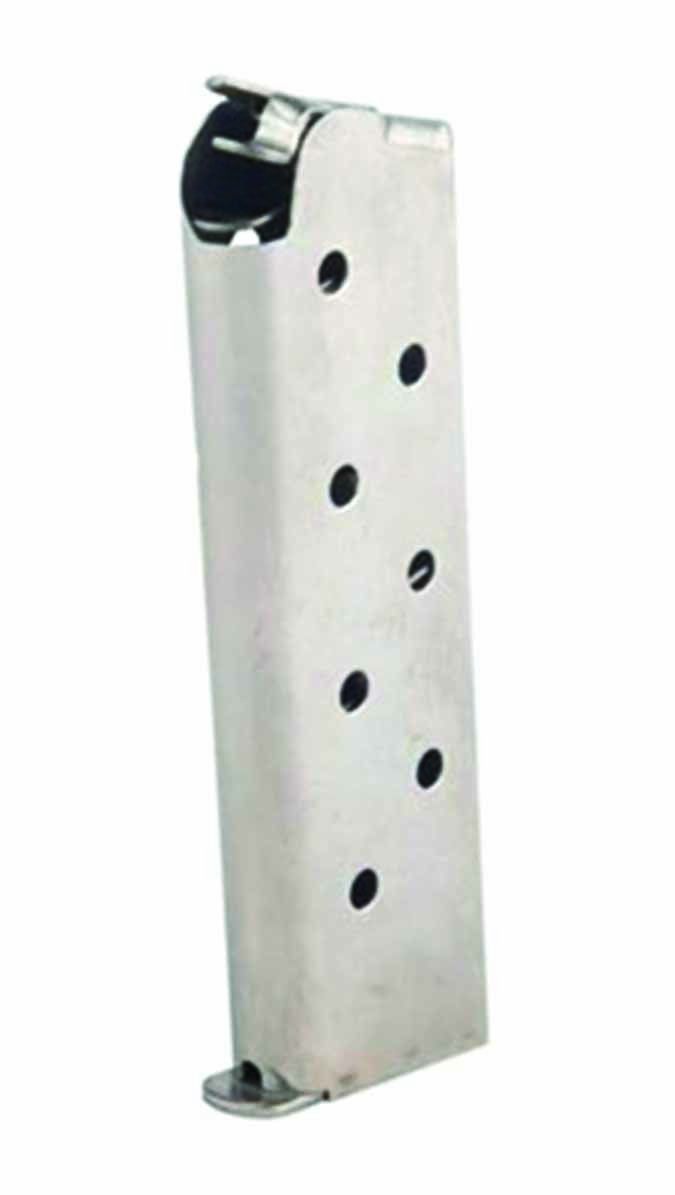
Triple-K 7-Round Magazine, $15
Available from Cabelas.com, we found the Triple-K magazine’s follower to be a poor fit. It seemed to protrude too much from the feed lips when the magazine is not loaded. This could possibly damage an aluminum feed ramp. The magazine fit and locked fine; however, during the drop tests, these magazines consistently lost two to four cartridges. The firing test was passed with standard loads, but not the +P. A Triple K magazine was the only magazine not to pass the 12-month spring test, losing magazine spring tension or perhaps the follower moved forward.
GUN TESTS GRADE: C
Written and photographed by R.K. Campbell, using evaluations from Gun Tests team testers.





























This test is incomplete with a magazine made by Checkmate. Those are available with wad cutter, GI, and hybrid feed lips. The hybrid feed lip mags are held in high esteem. They’re available in 7 round flush fit and 8 round extended tube models.
I don’t have any affiliation with Checkmate.
Great point! Thanks for the tip Brian.
Great read!!! Thank you for such a thorough test!!! Man the Mec Gar mag’s sure have increased in price over the last 10-15 years.
Why did you not test 10 rd mags?
Very pertinent article. I appreciate all the info, test results, opinions & pricing. Just purchased a new Desert Eagle DE1911C.
They come with 2 MecGar magazines.
After reading your article, I’m now buying 4 more of the same.
What, no Checkmate mags.???
The plain ‘ol blued Kimber 8 round magazines have worked great in my Colt 1911.
When I used to buy Kimber 1911’s their Tac-Mags were awful! This was six years ago but I had more problems with these mags and McCormick magazines. I always used Wilson 47D magazines and had no further problems with the pistols. I am very surprised to see the Pro Mags worked at all. Their Canik TP9 magazines are garbage with weak springs and ammunition not coming to the top after one or two fired… Thank you for your review. I use the Wilson 500 mags and 47D mags for any 1911 I use.
I have 3 Para Ordnance original factory 13 rd .45 mags. all have passed the same tests as yours except the drop tests, I try not to drop mine.
Thanks for reporting that P+ ammo cycles at a higher rate, affecting pickup of next round. Did not know that.
Small point of interest would be >>How would one go about measuring the cycle rate of ammo with a high speed video camera/Phone ? ( phone app -? ) standard vel ammo of major companies probably show small variance ( with a stated weight bullet ). I would wish to know where I might rent a hi-speed video cam to play around with this thought. cycle speed of a .22 cal, 9mm., .45cal. pistols.
I have used the 45ACP for almost 50 yrs. now. By far and away the best mags I have used were Wilson Combat. I have never had a problem with them. I have yet to own one that I needed to replace. Since I carry daily I can attest to the serviceability of these mags.
I read all the way up to where you called them wilson mags. Chip McCormick made wilson mags and now they own chip mccormick so no I will not use anything with the name wilson on it even trapped on a deserted island.
Got 2 mags when I bought my Tsias 1911 .45. One just didn,’t feed at all without causing a jam during break-in. The other one worked intermittently. I only use Kimber maps now. No problems at all. Why not keep 8 rounds in an 8 round mag?
Add around $10 to each of these, the prices will be more accurate for 2024. Inflation sucks
First off I want to say awesome blog! I had a quick question that I’d like to ask if you do not mind. I was interested to know how you center yourself and clear your thoughts before writing. I have had a tough time clearing my mind in getting my thoughts out there. I truly do take pleasure in writing however it just seems like the first 10 to 15 minutes are generally lost simply just trying to figure out how to begin. Any recommendations or tips? Thanks!
pharmacie en ligne pas cher [url=http://pharmafst.com/#]pharmacie en ligne[/url] trouver un mГ©dicament en pharmacie pharmafst.shop
pharmacie en ligne livraison europe [url=https://pharmafst.com/#]pharmacie en ligne sans ordonnance[/url] pharmacie en ligne fiable pharmafst.shop
Pharmacie sans ordonnance [url=http://pharmafst.com/#]Medicaments en ligne livres en 24h[/url] Pharmacie Internationale en ligne pharmafst.shop
pharmacie en ligne [url=https://pharmafst.com/#]Pharmacie en ligne France[/url] pharmacie en ligne france livraison belgique pharmafst.shop
п»їpharmacie en ligne france [url=https://pharmafst.com/#]Medicaments en ligne livres en 24h[/url] pharmacie en ligne france livraison belgique pharmafst.shop
cialis generique [url=https://tadalmed.com/#]Acheter Cialis 20 mg pas cher[/url] Tadalafil achat en ligne tadalmed.com
Cialis en ligne [url=https://tadalmed.com/#]Pharmacie en ligne Cialis sans ordonnance[/url] Cialis sans ordonnance 24h tadalmed.com